TESCO: HR Professional Skills, Training Needs and Development Report
VerifiedAdded on 2020/06/04
|18
|5488
|27
Report
AI Summary
This report focuses on the skills, knowledge, and behavior of HR professionals, particularly within the context of TESCO, a major retail company. Task 1 delves into the essential skills required for HR roles, including resource management, communication, leadership, and analytical thinking. It also examines the knowledge base needed, such as business acumen, labor legislation, and international HRM practices. Furthermore, the report addresses the identification of training and development needs through skill audits, illustrated by a SWOT analysis. Task 2 explores the role of HR in employee engagement and different approaches to performance management. The report emphasizes the importance of continuous learning and professional development for both individuals and organizations. The personal and professional development plan for a HR officer, Jane Cambridge, is also discussed, highlighting areas for improvement and opportunities for growth. The report concludes with a discussion on the importance of ethical behavior, fairness, and effective communication in HR practices.
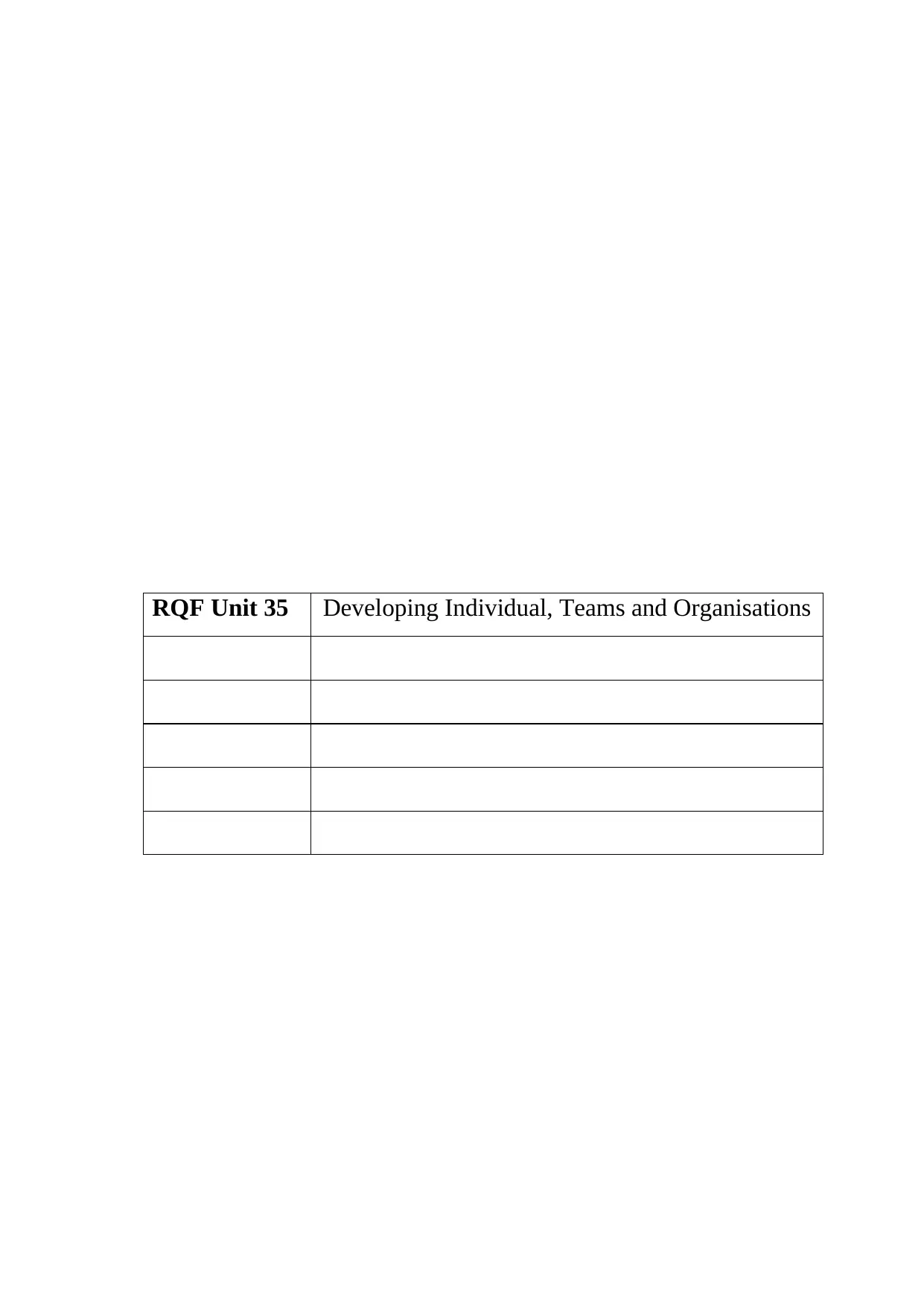
RQF Unit 35 Developing Individual, Teams and Organisations
Paraphrase This Document
Need a fresh take? Get an instant paraphrase of this document with our AI Paraphraser
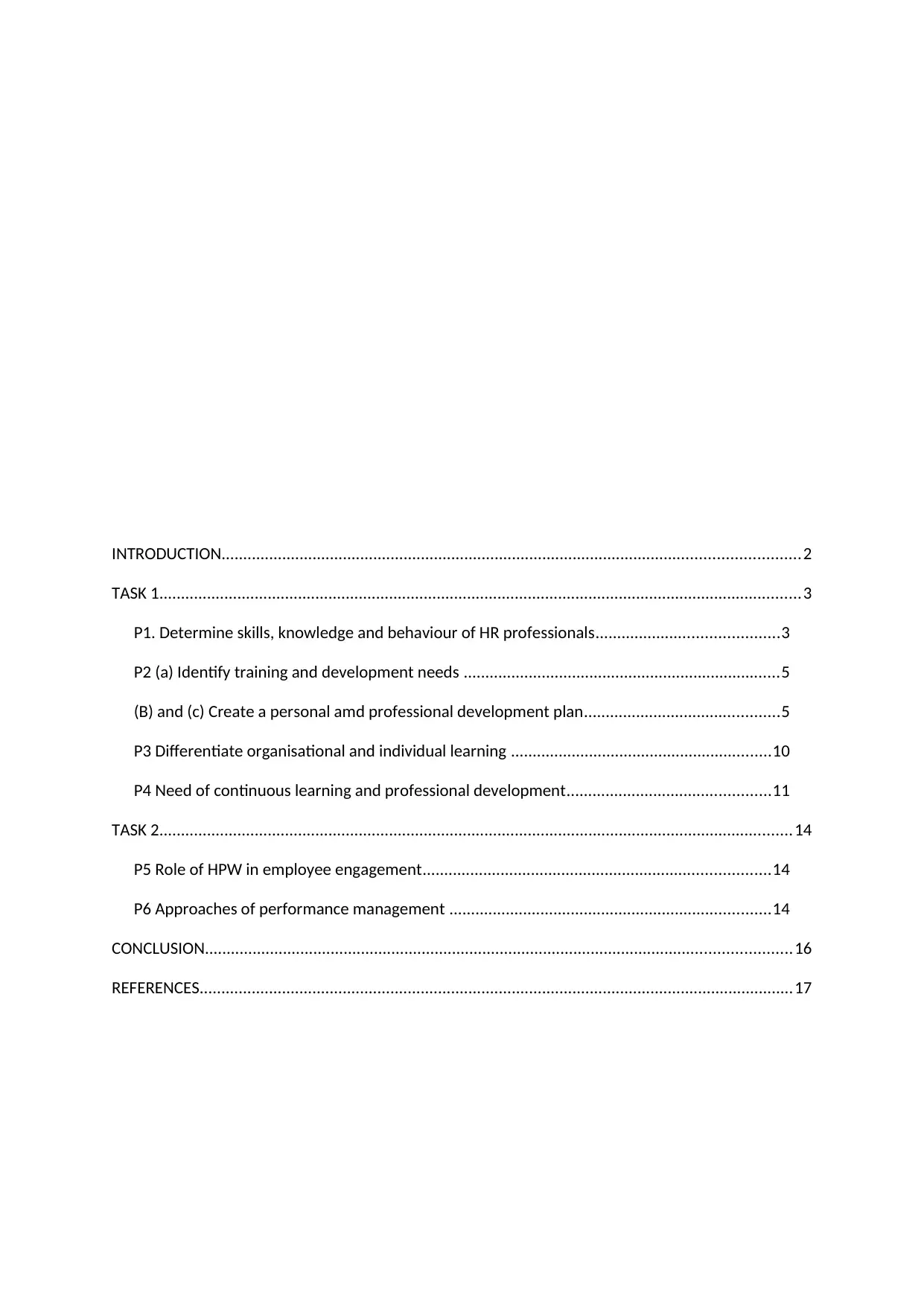
INTRODUCTION.....................................................................................................................................2
TASK 1....................................................................................................................................................3
P1. Determine skills, knowledge and behaviour of HR professionals..........................................3
P2 (a) Identify training and development needs .........................................................................5
(B) and (c) Create a personal amd professional development plan.............................................5
P3 Differentiate organisational and individual learning ............................................................10
P4 Need of continuous learning and professional development...............................................11
TASK 2..................................................................................................................................................14
P5 Role of HPW in employee engagement................................................................................14
P6 Approaches of performance management ..........................................................................14
CONCLUSION.......................................................................................................................................16
REFERENCES.........................................................................................................................................17
TASK 1....................................................................................................................................................3
P1. Determine skills, knowledge and behaviour of HR professionals..........................................3
P2 (a) Identify training and development needs .........................................................................5
(B) and (c) Create a personal amd professional development plan.............................................5
P3 Differentiate organisational and individual learning ............................................................10
P4 Need of continuous learning and professional development...............................................11
TASK 2..................................................................................................................................................14
P5 Role of HPW in employee engagement................................................................................14
P6 Approaches of performance management ..........................................................................14
CONCLUSION.......................................................................................................................................16
REFERENCES.........................................................................................................................................17
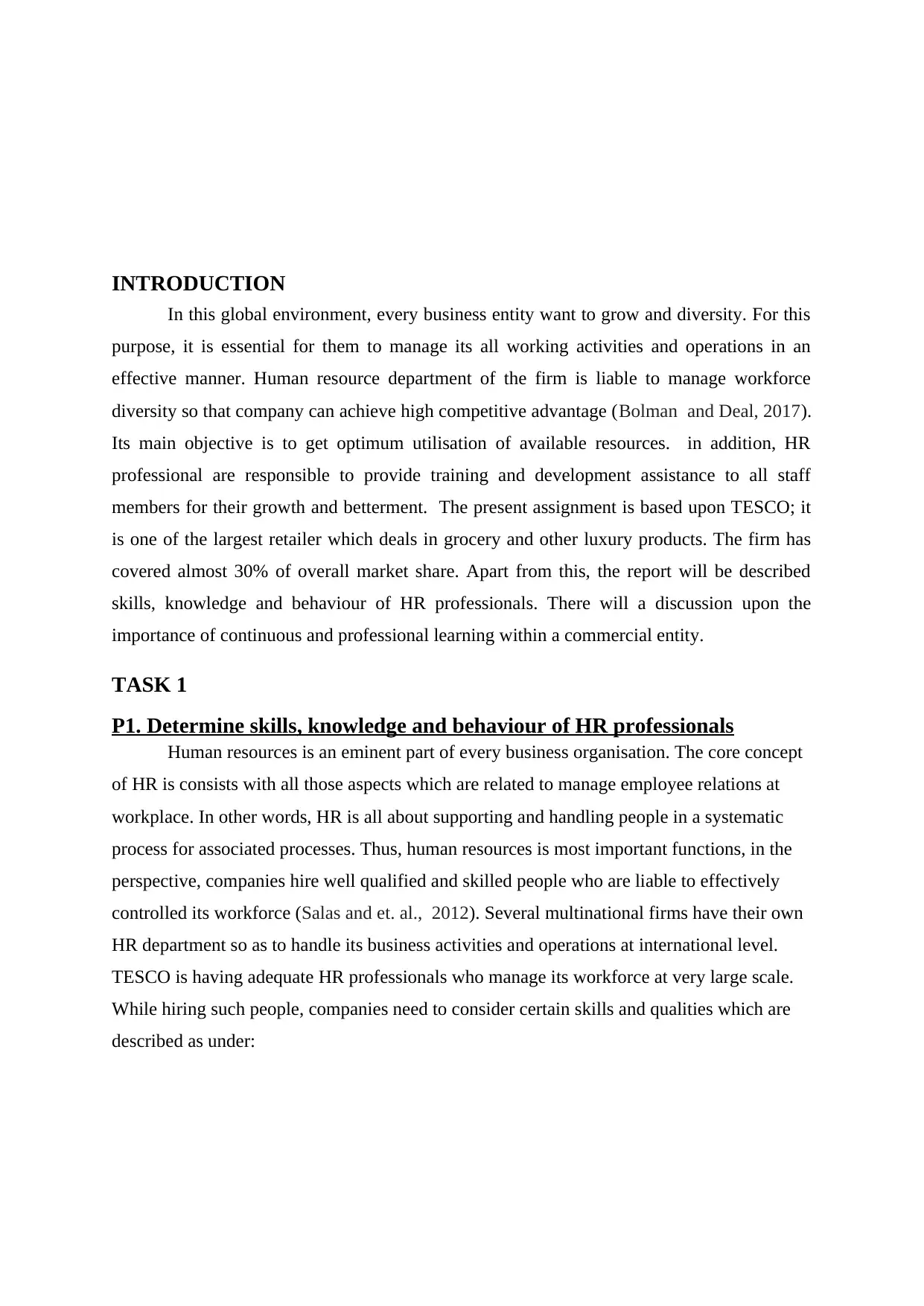
INTRODUCTION
In this global environment, every business entity want to grow and diversity. For this
purpose, it is essential for them to manage its all working activities and operations in an
effective manner. Human resource department of the firm is liable to manage workforce
diversity so that company can achieve high competitive advantage (Bolman and Deal, 2017).
Its main objective is to get optimum utilisation of available resources. in addition, HR
professional are responsible to provide training and development assistance to all staff
members for their growth and betterment. The present assignment is based upon TESCO; it
is one of the largest retailer which deals in grocery and other luxury products. The firm has
covered almost 30% of overall market share. Apart from this, the report will be described
skills, knowledge and behaviour of HR professionals. There will a discussion upon the
importance of continuous and professional learning within a commercial entity.
TASK 1
P1. Determine skills, knowledge and behaviour of HR professionals
Human resources is an eminent part of every business organisation. The core concept
of HR is consists with all those aspects which are related to manage employee relations at
workplace. In other words, HR is all about supporting and handling people in a systematic
process for associated processes. Thus, human resources is most important functions, in the
perspective, companies hire well qualified and skilled people who are liable to effectively
controlled its workforce (Salas and et. al., 2012). Several multinational firms have their own
HR department so as to handle its business activities and operations at international level.
TESCO is having adequate HR professionals who manage its workforce at very large scale.
While hiring such people, companies need to consider certain skills and qualities which are
described as under:
In this global environment, every business entity want to grow and diversity. For this
purpose, it is essential for them to manage its all working activities and operations in an
effective manner. Human resource department of the firm is liable to manage workforce
diversity so that company can achieve high competitive advantage (Bolman and Deal, 2017).
Its main objective is to get optimum utilisation of available resources. in addition, HR
professional are responsible to provide training and development assistance to all staff
members for their growth and betterment. The present assignment is based upon TESCO; it
is one of the largest retailer which deals in grocery and other luxury products. The firm has
covered almost 30% of overall market share. Apart from this, the report will be described
skills, knowledge and behaviour of HR professionals. There will a discussion upon the
importance of continuous and professional learning within a commercial entity.
TASK 1
P1. Determine skills, knowledge and behaviour of HR professionals
Human resources is an eminent part of every business organisation. The core concept
of HR is consists with all those aspects which are related to manage employee relations at
workplace. In other words, HR is all about supporting and handling people in a systematic
process for associated processes. Thus, human resources is most important functions, in the
perspective, companies hire well qualified and skilled people who are liable to effectively
controlled its workforce (Salas and et. al., 2012). Several multinational firms have their own
HR department so as to handle its business activities and operations at international level.
TESCO is having adequate HR professionals who manage its workforce at very large scale.
While hiring such people, companies need to consider certain skills and qualities which are
described as under:
⊘ This is a preview!⊘
Do you want full access?
Subscribe today to unlock all pages.

Trusted by 1+ million students worldwide
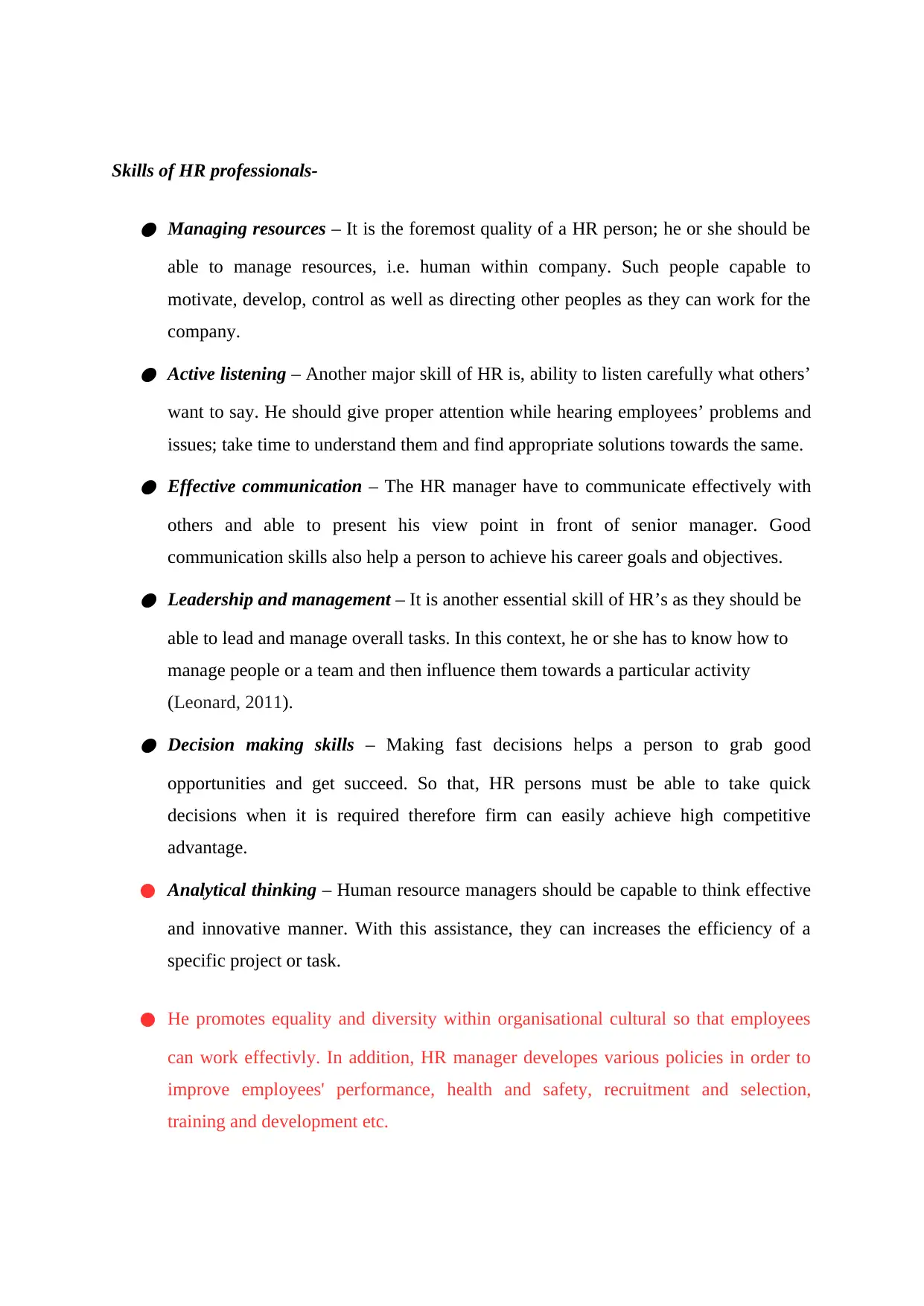
Skills of HR professionals-
● Managing resources – It is the foremost quality of a HR person; he or she should be
able to manage resources, i.e. human within company. Such people capable to
motivate, develop, control as well as directing other peoples as they can work for the
company.● Active listening – Another major skill of HR is, ability to listen carefully what others’
want to say. He should give proper attention while hearing employees’ problems and
issues; take time to understand them and find appropriate solutions towards the same.● Effective communication – The HR manager have to communicate effectively with
others and able to present his view point in front of senior manager. Good
communication skills also help a person to achieve his career goals and objectives.● Leadership and management – It is another essential skill of HR’s as they should be
able to lead and manage overall tasks. In this context, he or she has to know how to
manage people or a team and then influence them towards a particular activity
(Leonard, 2011).● Decision making skills – Making fast decisions helps a person to grab good
opportunities and get succeed. So that, HR persons must be able to take quick
decisions when it is required therefore firm can easily achieve high competitive
advantage.
● Analytical thinking – Human resource managers should be capable to think effective
and innovative manner. With this assistance, they can increases the efficiency of a
specific project or task.
● He promotes equality and diversity within organisational cultural so that employees
can work effectivly. In addition, HR manager developes various policies in order to
improve employees' performance, health and safety, recruitment and selection,
training and development etc.
● Managing resources – It is the foremost quality of a HR person; he or she should be
able to manage resources, i.e. human within company. Such people capable to
motivate, develop, control as well as directing other peoples as they can work for the
company.● Active listening – Another major skill of HR is, ability to listen carefully what others’
want to say. He should give proper attention while hearing employees’ problems and
issues; take time to understand them and find appropriate solutions towards the same.● Effective communication – The HR manager have to communicate effectively with
others and able to present his view point in front of senior manager. Good
communication skills also help a person to achieve his career goals and objectives.● Leadership and management – It is another essential skill of HR’s as they should be
able to lead and manage overall tasks. In this context, he or she has to know how to
manage people or a team and then influence them towards a particular activity
(Leonard, 2011).● Decision making skills – Making fast decisions helps a person to grab good
opportunities and get succeed. So that, HR persons must be able to take quick
decisions when it is required therefore firm can easily achieve high competitive
advantage.
● Analytical thinking – Human resource managers should be capable to think effective
and innovative manner. With this assistance, they can increases the efficiency of a
specific project or task.
● He promotes equality and diversity within organisational cultural so that employees
can work effectivly. In addition, HR manager developes various policies in order to
improve employees' performance, health and safety, recruitment and selection,
training and development etc.
Paraphrase This Document
Need a fresh take? Get an instant paraphrase of this document with our AI Paraphraser
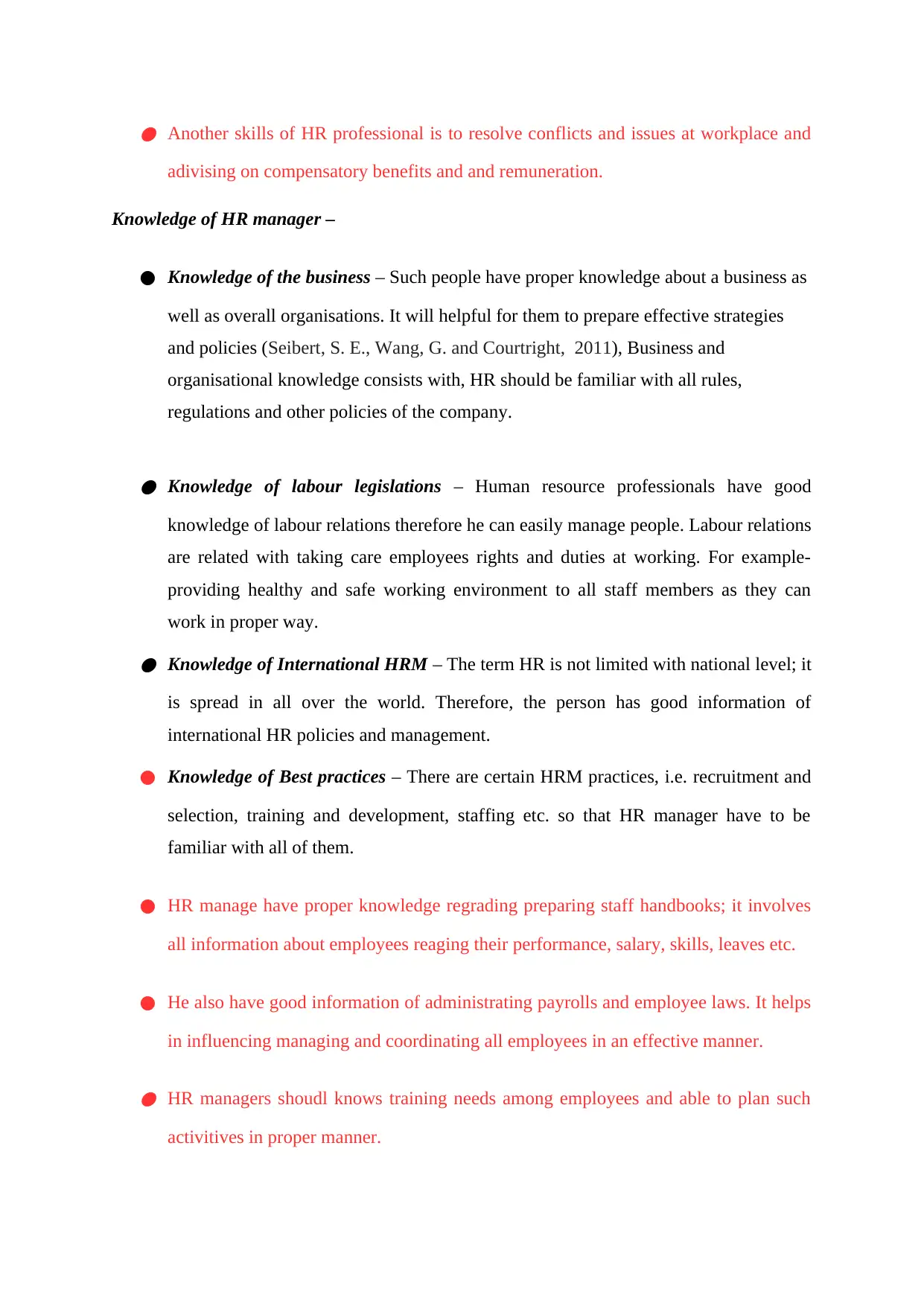
● Another skills of HR professional is to resolve conflicts and issues at workplace and
adivising on compensatory benefits and and remuneration.
Knowledge of HR manager –
● Knowledge of the business – Such people have proper knowledge about a business as
well as overall organisations. It will helpful for them to prepare effective strategies
and policies (Seibert, S. E., Wang, G. and Courtright, 2011), Business and
organisational knowledge consists with, HR should be familiar with all rules,
regulations and other policies of the company.
● Knowledge of labour legislations – Human resource professionals have good
knowledge of labour relations therefore he can easily manage people. Labour relations
are related with taking care employees rights and duties at working. For example-
providing healthy and safe working environment to all staff members as they can
work in proper way.● Knowledge of International HRM – The term HR is not limited with national level; it
is spread in all over the world. Therefore, the person has good information of
international HR policies and management.
● Knowledge of Best practices – There are certain HRM practices, i.e. recruitment and
selection, training and development, staffing etc. so that HR manager have to be
familiar with all of them.
● HR manage have proper knowledge regrading preparing staff handbooks; it involves
all information about employees reaging their performance, salary, skills, leaves etc.
● He also have good information of administrating payrolls and employee laws. It helps
in influencing managing and coordinating all employees in an effective manner.
● HR managers shoudl knows training needs among employees and able to plan such
activitives in proper manner.
adivising on compensatory benefits and and remuneration.
Knowledge of HR manager –
● Knowledge of the business – Such people have proper knowledge about a business as
well as overall organisations. It will helpful for them to prepare effective strategies
and policies (Seibert, S. E., Wang, G. and Courtright, 2011), Business and
organisational knowledge consists with, HR should be familiar with all rules,
regulations and other policies of the company.
● Knowledge of labour legislations – Human resource professionals have good
knowledge of labour relations therefore he can easily manage people. Labour relations
are related with taking care employees rights and duties at working. For example-
providing healthy and safe working environment to all staff members as they can
work in proper way.● Knowledge of International HRM – The term HR is not limited with national level; it
is spread in all over the world. Therefore, the person has good information of
international HR policies and management.
● Knowledge of Best practices – There are certain HRM practices, i.e. recruitment and
selection, training and development, staffing etc. so that HR manager have to be
familiar with all of them.
● HR manage have proper knowledge regrading preparing staff handbooks; it involves
all information about employees reaging their performance, salary, skills, leaves etc.
● He also have good information of administrating payrolls and employee laws. It helps
in influencing managing and coordinating all employees in an effective manner.
● HR managers shoudl knows training needs among employees and able to plan such
activitives in proper manner.
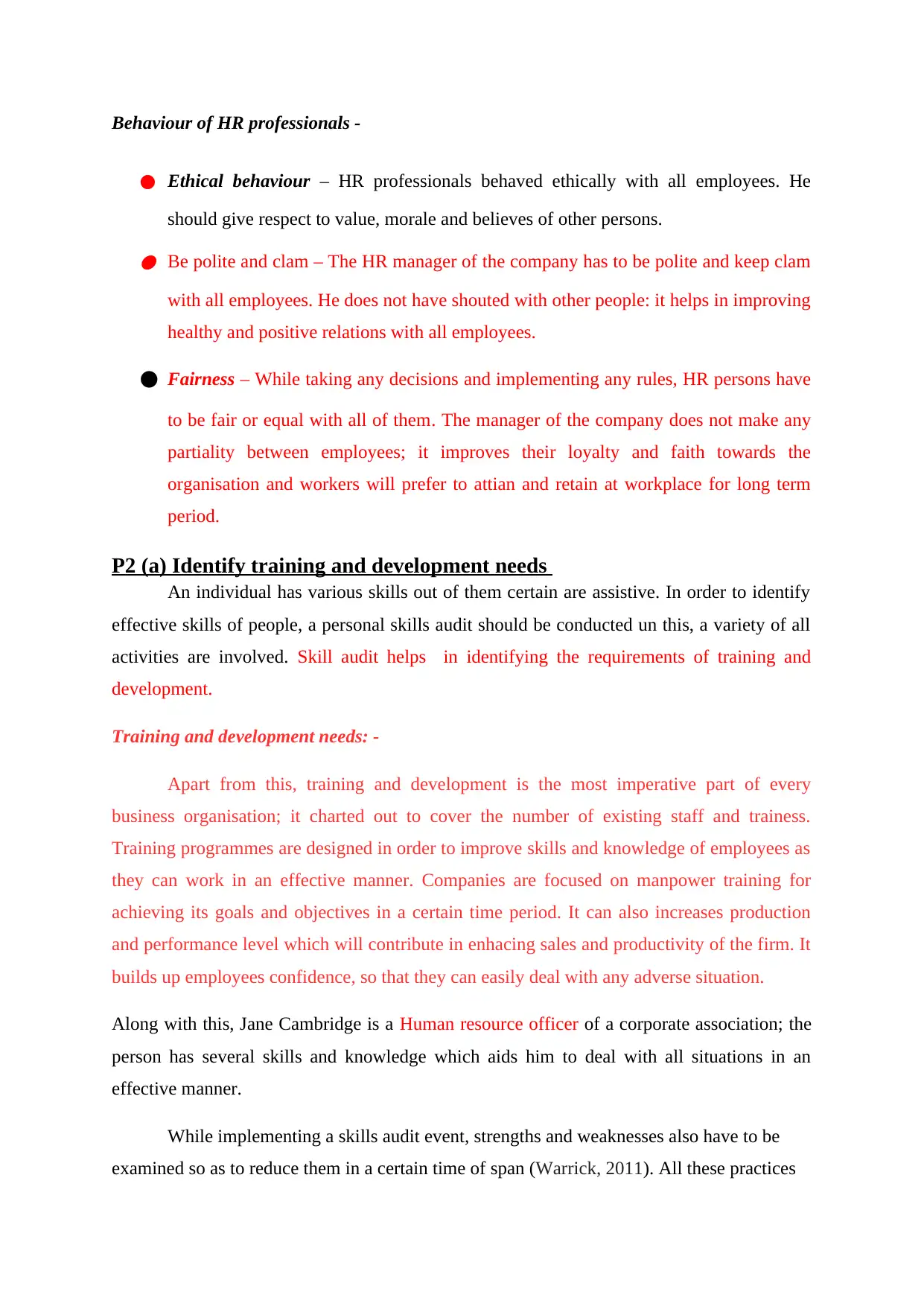
Behaviour of HR professionals -
● Ethical behaviour – HR professionals behaved ethically with all employees. He
should give respect to value, morale and believes of other persons.● Be polite and clam – The HR manager of the company has to be polite and keep clam
with all employees. He does not have shouted with other people: it helps in improving
healthy and positive relations with all employees.
● Fairness – While taking any decisions and implementing any rules, HR persons have
to be fair or equal with all of them. The manager of the company does not make any
partiality between employees; it improves their loyalty and faith towards the
organisation and workers will prefer to attian and retain at workplace for long term
period.
P2 (a) Identify training and development needs
An individual has various skills out of them certain are assistive. In order to identify
effective skills of people, a personal skills audit should be conducted un this, a variety of all
activities are involved. Skill audit helps in identifying the requirements of training and
development.
Training and development needs: -
Apart from this, training and development is the most imperative part of every
business organisation; it charted out to cover the number of existing staff and trainess.
Training programmes are designed in order to improve skills and knowledge of employees as
they can work in an effective manner. Companies are focused on manpower training for
achieving its goals and objectives in a certain time period. It can also increases production
and performance level which will contribute in enhacing sales and productivity of the firm. It
builds up employees confidence, so that they can easily deal with any adverse situation.
Along with this, Jane Cambridge is a Human resource officer of a corporate association; the
person has several skills and knowledge which aids him to deal with all situations in an
effective manner.
While implementing a skills audit event, strengths and weaknesses also have to be
examined so as to reduce them in a certain time of span (Warrick, 2011). All these practices
● Ethical behaviour – HR professionals behaved ethically with all employees. He
should give respect to value, morale and believes of other persons.● Be polite and clam – The HR manager of the company has to be polite and keep clam
with all employees. He does not have shouted with other people: it helps in improving
healthy and positive relations with all employees.
● Fairness – While taking any decisions and implementing any rules, HR persons have
to be fair or equal with all of them. The manager of the company does not make any
partiality between employees; it improves their loyalty and faith towards the
organisation and workers will prefer to attian and retain at workplace for long term
period.
P2 (a) Identify training and development needs
An individual has various skills out of them certain are assistive. In order to identify
effective skills of people, a personal skills audit should be conducted un this, a variety of all
activities are involved. Skill audit helps in identifying the requirements of training and
development.
Training and development needs: -
Apart from this, training and development is the most imperative part of every
business organisation; it charted out to cover the number of existing staff and trainess.
Training programmes are designed in order to improve skills and knowledge of employees as
they can work in an effective manner. Companies are focused on manpower training for
achieving its goals and objectives in a certain time period. It can also increases production
and performance level which will contribute in enhacing sales and productivity of the firm. It
builds up employees confidence, so that they can easily deal with any adverse situation.
Along with this, Jane Cambridge is a Human resource officer of a corporate association; the
person has several skills and knowledge which aids him to deal with all situations in an
effective manner.
While implementing a skills audit event, strengths and weaknesses also have to be
examined so as to reduce them in a certain time of span (Warrick, 2011). All these practices
⊘ This is a preview!⊘
Do you want full access?
Subscribe today to unlock all pages.

Trusted by 1+ million students worldwide
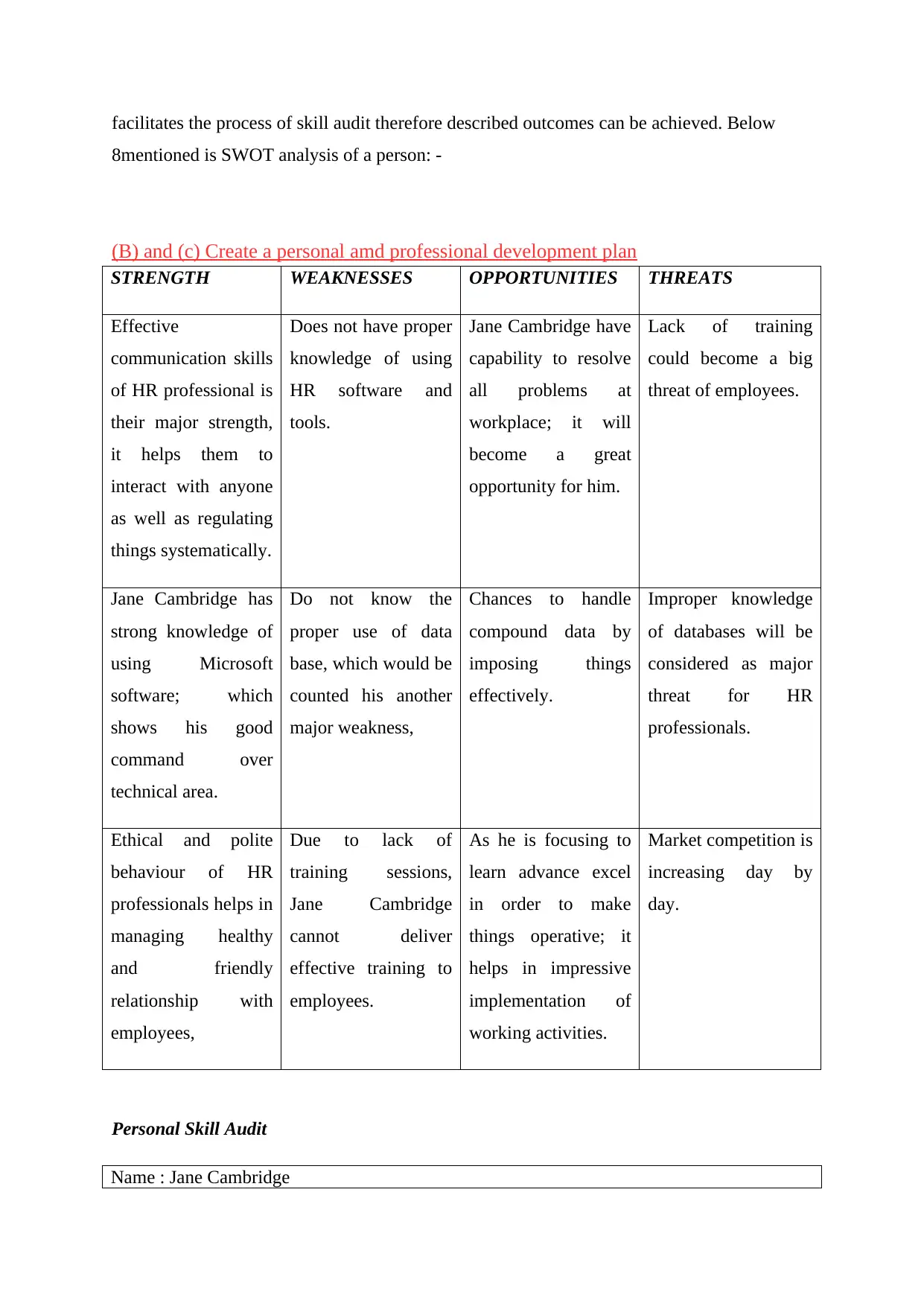
facilitates the process of skill audit therefore described outcomes can be achieved. Below
8mentioned is SWOT analysis of a person: -
(B) and (c) Create a personal amd professional development plan
STRENGTH WEAKNESSES OPPORTUNITIES THREATS
Effective
communication skills
of HR professional is
their major strength,
it helps them to
interact with anyone
as well as regulating
things systematically.
Does not have proper
knowledge of using
HR software and
tools.
Jane Cambridge have
capability to resolve
all problems at
workplace; it will
become a great
opportunity for him.
Lack of training
could become a big
threat of employees.
Jane Cambridge has
strong knowledge of
using Microsoft
software; which
shows his good
command over
technical area.
Do not know the
proper use of data
base, which would be
counted his another
major weakness,
Chances to handle
compound data by
imposing things
effectively.
Improper knowledge
of databases will be
considered as major
threat for HR
professionals.
Ethical and polite
behaviour of HR
professionals helps in
managing healthy
and friendly
relationship with
employees,
Due to lack of
training sessions,
Jane Cambridge
cannot deliver
effective training to
employees.
As he is focusing to
learn advance excel
in order to make
things operative; it
helps in impressive
implementation of
working activities.
Market competition is
increasing day by
day.
Personal Skill Audit
Name : Jane Cambridge
8mentioned is SWOT analysis of a person: -
(B) and (c) Create a personal amd professional development plan
STRENGTH WEAKNESSES OPPORTUNITIES THREATS
Effective
communication skills
of HR professional is
their major strength,
it helps them to
interact with anyone
as well as regulating
things systematically.
Does not have proper
knowledge of using
HR software and
tools.
Jane Cambridge have
capability to resolve
all problems at
workplace; it will
become a great
opportunity for him.
Lack of training
could become a big
threat of employees.
Jane Cambridge has
strong knowledge of
using Microsoft
software; which
shows his good
command over
technical area.
Do not know the
proper use of data
base, which would be
counted his another
major weakness,
Chances to handle
compound data by
imposing things
effectively.
Improper knowledge
of databases will be
considered as major
threat for HR
professionals.
Ethical and polite
behaviour of HR
professionals helps in
managing healthy
and friendly
relationship with
employees,
Due to lack of
training sessions,
Jane Cambridge
cannot deliver
effective training to
employees.
As he is focusing to
learn advance excel
in order to make
things operative; it
helps in impressive
implementation of
working activities.
Market competition is
increasing day by
day.
Personal Skill Audit
Name : Jane Cambridge
Paraphrase This Document
Need a fresh take? Get an instant paraphrase of this document with our AI Paraphraser
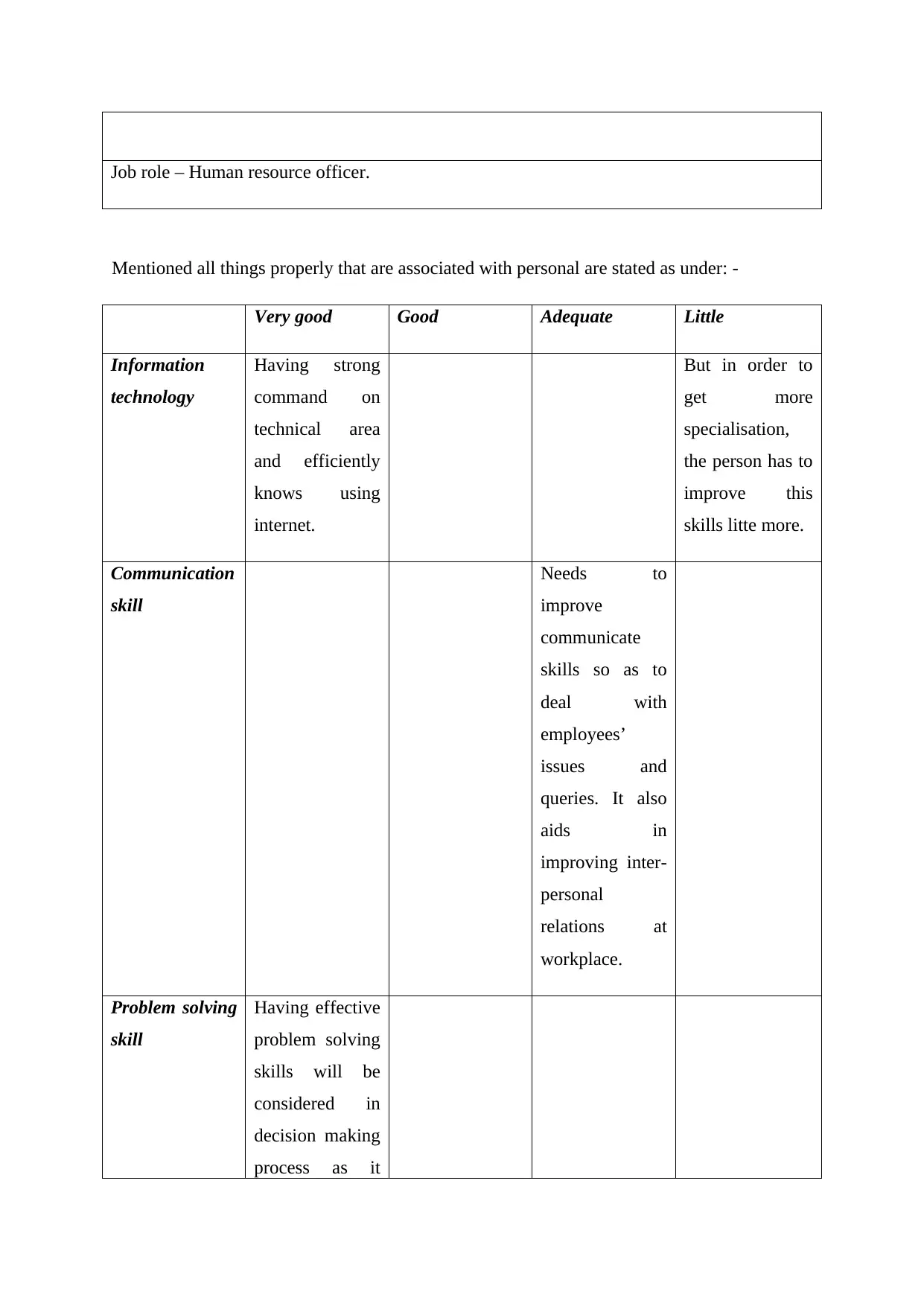
Job role – Human resource officer.
Mentioned all things properly that are associated with personal are stated as under: -
Very good Good Adequate Little
Information
technology
Having strong
command on
technical area
and efficiently
knows using
internet.
But in order to
get more
specialisation,
the person has to
improve this
skills litte more.
Communication
skill
Needs to
improve
communicate
skills so as to
deal with
employees’
issues and
queries. It also
aids in
improving inter-
personal
relations at
workplace.
Problem solving
skill
Having effective
problem solving
skills will be
considered in
decision making
process as it
Mentioned all things properly that are associated with personal are stated as under: -
Very good Good Adequate Little
Information
technology
Having strong
command on
technical area
and efficiently
knows using
internet.
But in order to
get more
specialisation,
the person has to
improve this
skills litte more.
Communication
skill
Needs to
improve
communicate
skills so as to
deal with
employees’
issues and
queries. It also
aids in
improving inter-
personal
relations at
workplace.
Problem solving
skill
Having effective
problem solving
skills will be
considered in
decision making
process as it
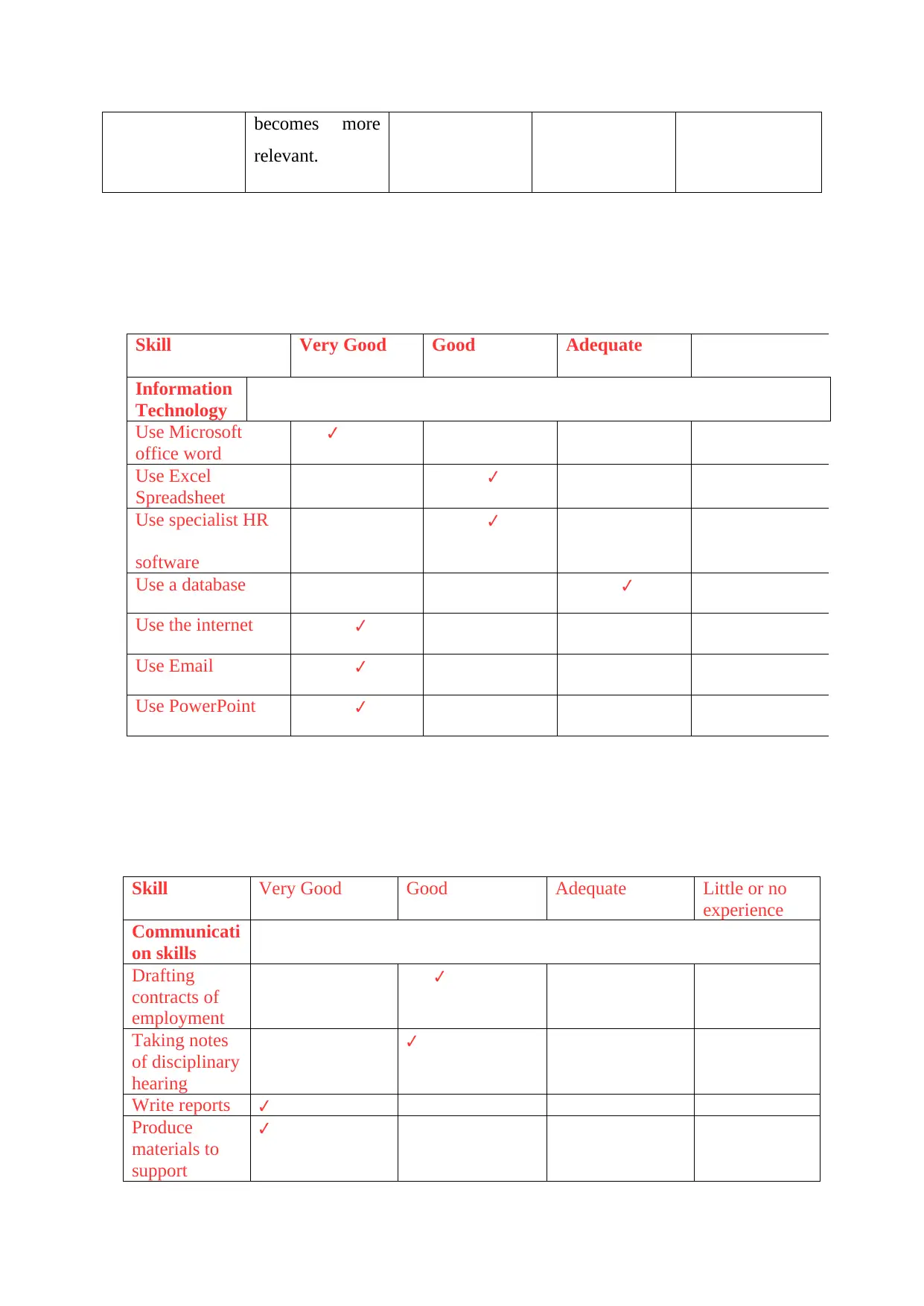
becomes more
relevant.
Skill Very Good Good Adequate
Information
Technology
Use Microsoft
office word
✔
Use Excel
Spreadsheet
✔
Use specialist HR
software
✔
Use a database ✔
Use the internet ✔
Use Email ✔
Use PowerPoint ✔
Skill Very Good Good Adequate Little or no
experience
Communicati
on skills
Drafting
contracts of
employment
✔
Taking notes
of disciplinary
hearing
✔
Write reports ✔
Produce
materials to
support
✔
relevant.
Skill Very Good Good Adequate
Information
Technology
Use Microsoft
office word
✔
Use Excel
Spreadsheet
✔
Use specialist HR
software
✔
Use a database ✔
Use the internet ✔
Use Email ✔
Use PowerPoint ✔
Skill Very Good Good Adequate Little or no
experience
Communicati
on skills
Drafting
contracts of
employment
✔
Taking notes
of disciplinary
hearing
✔
Write reports ✔
Produce
materials to
support
✔
⊘ This is a preview!⊘
Do you want full access?
Subscribe today to unlock all pages.

Trusted by 1+ million students worldwide
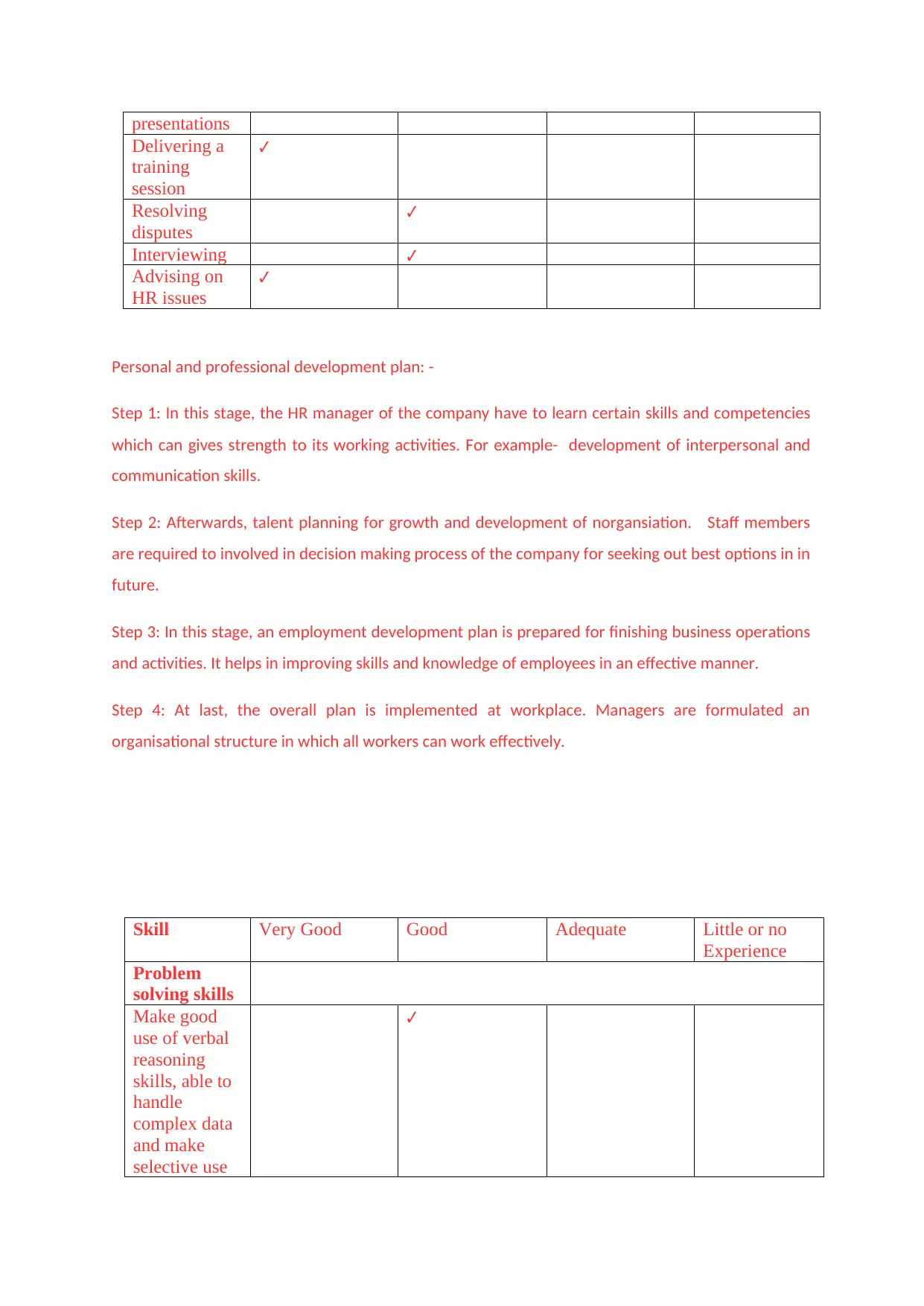
presentations
Delivering a
training
session
✔
Resolving
disputes
✔
Interviewing ✔
Advising on
HR issues
✔
Personal and professional development plan: -
Step 1: In this stage, the HR manager of the company have to learn certain skills and competencies
which can gives strength to its working activities. For example- development of interpersonal and
communication skills.
Step 2: Afterwards, talent planning for growth and development of norgansiation. Staff members
are required to involved in decision making process of the company for seeking out best options in in
future.
Step 3: In this stage, an employment development plan is prepared for finishing business operations
and activities. It helps in improving skills and knowledge of employees in an effective manner.
Step 4: At last, the overall plan is implemented at workplace. Managers are formulated an
organisational structure in which all workers can work effectively.
Skill Very Good Good Adequate Little or no
Experience
Problem
solving skills
Make good
use of verbal
reasoning
skills, able to
handle
complex data
and make
selective use
✔
Delivering a
training
session
✔
Resolving
disputes
✔
Interviewing ✔
Advising on
HR issues
✔
Personal and professional development plan: -
Step 1: In this stage, the HR manager of the company have to learn certain skills and competencies
which can gives strength to its working activities. For example- development of interpersonal and
communication skills.
Step 2: Afterwards, talent planning for growth and development of norgansiation. Staff members
are required to involved in decision making process of the company for seeking out best options in in
future.
Step 3: In this stage, an employment development plan is prepared for finishing business operations
and activities. It helps in improving skills and knowledge of employees in an effective manner.
Step 4: At last, the overall plan is implemented at workplace. Managers are formulated an
organisational structure in which all workers can work effectively.
Skill Very Good Good Adequate Little or no
Experience
Problem
solving skills
Make good
use of verbal
reasoning
skills, able to
handle
complex data
and make
selective use
✔
Paraphrase This Document
Need a fresh take? Get an instant paraphrase of this document with our AI Paraphraser
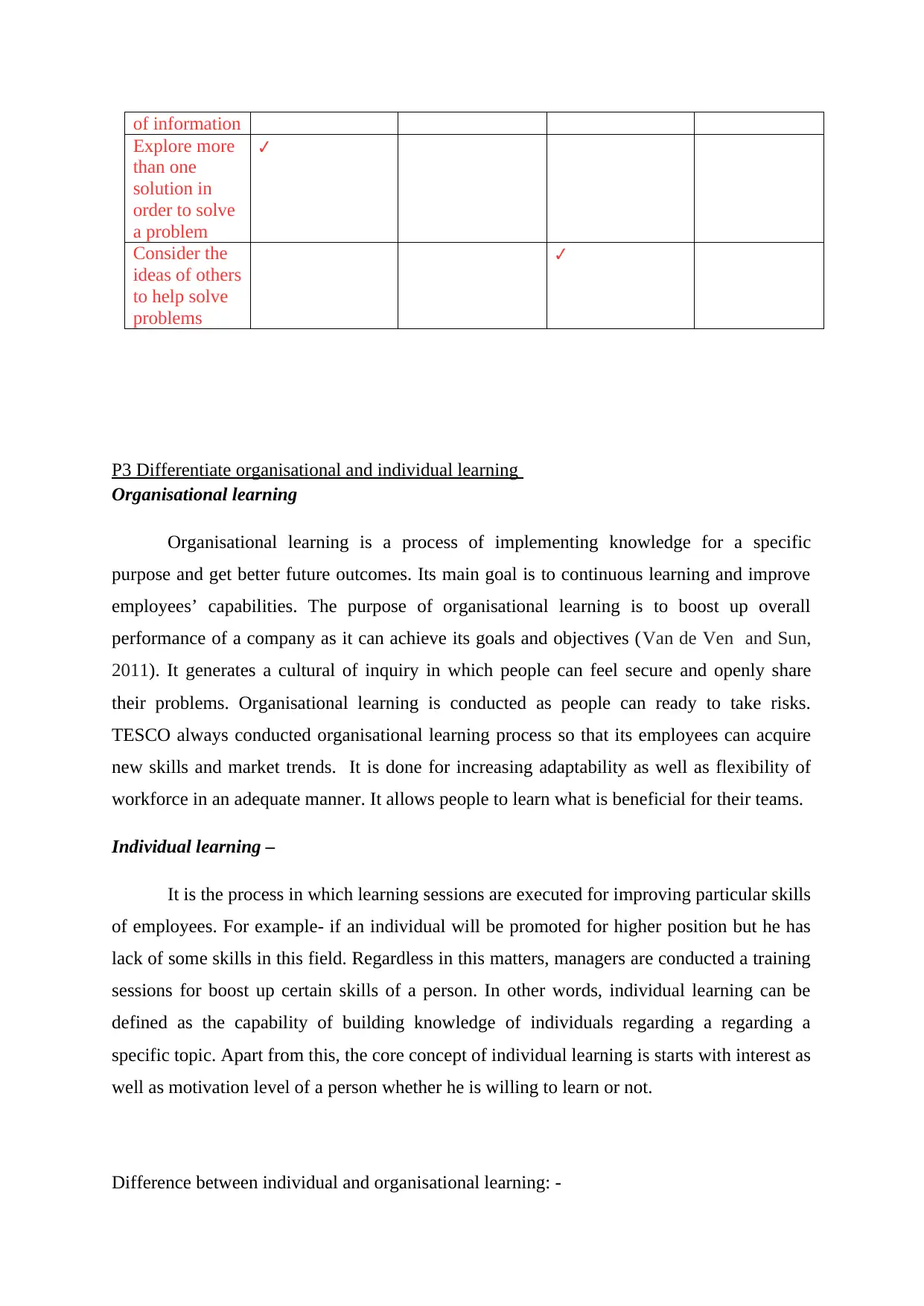
of information
Explore more
than one
solution in
order to solve
a problem
✔
Consider the
ideas of others
to help solve
problems
✔
P3 Differentiate organisational and individual learning
Organisational learning
Organisational learning is a process of implementing knowledge for a specific
purpose and get better future outcomes. Its main goal is to continuous learning and improve
employees’ capabilities. The purpose of organisational learning is to boost up overall
performance of a company as it can achieve its goals and objectives (Van de Ven and Sun,
2011). It generates a cultural of inquiry in which people can feel secure and openly share
their problems. Organisational learning is conducted as people can ready to take risks.
TESCO always conducted organisational learning process so that its employees can acquire
new skills and market trends. It is done for increasing adaptability as well as flexibility of
workforce in an adequate manner. It allows people to learn what is beneficial for their teams.
Individual learning –
It is the process in which learning sessions are executed for improving particular skills
of employees. For example- if an individual will be promoted for higher position but he has
lack of some skills in this field. Regardless in this matters, managers are conducted a training
sessions for boost up certain skills of a person. In other words, individual learning can be
defined as the capability of building knowledge of individuals regarding a regarding a
specific topic. Apart from this, the core concept of individual learning is starts with interest as
well as motivation level of a person whether he is willing to learn or not.
Difference between individual and organisational learning: -
Explore more
than one
solution in
order to solve
a problem
✔
Consider the
ideas of others
to help solve
problems
✔
P3 Differentiate organisational and individual learning
Organisational learning
Organisational learning is a process of implementing knowledge for a specific
purpose and get better future outcomes. Its main goal is to continuous learning and improve
employees’ capabilities. The purpose of organisational learning is to boost up overall
performance of a company as it can achieve its goals and objectives (Van de Ven and Sun,
2011). It generates a cultural of inquiry in which people can feel secure and openly share
their problems. Organisational learning is conducted as people can ready to take risks.
TESCO always conducted organisational learning process so that its employees can acquire
new skills and market trends. It is done for increasing adaptability as well as flexibility of
workforce in an adequate manner. It allows people to learn what is beneficial for their teams.
Individual learning –
It is the process in which learning sessions are executed for improving particular skills
of employees. For example- if an individual will be promoted for higher position but he has
lack of some skills in this field. Regardless in this matters, managers are conducted a training
sessions for boost up certain skills of a person. In other words, individual learning can be
defined as the capability of building knowledge of individuals regarding a regarding a
specific topic. Apart from this, the core concept of individual learning is starts with interest as
well as motivation level of a person whether he is willing to learn or not.
Difference between individual and organisational learning: -
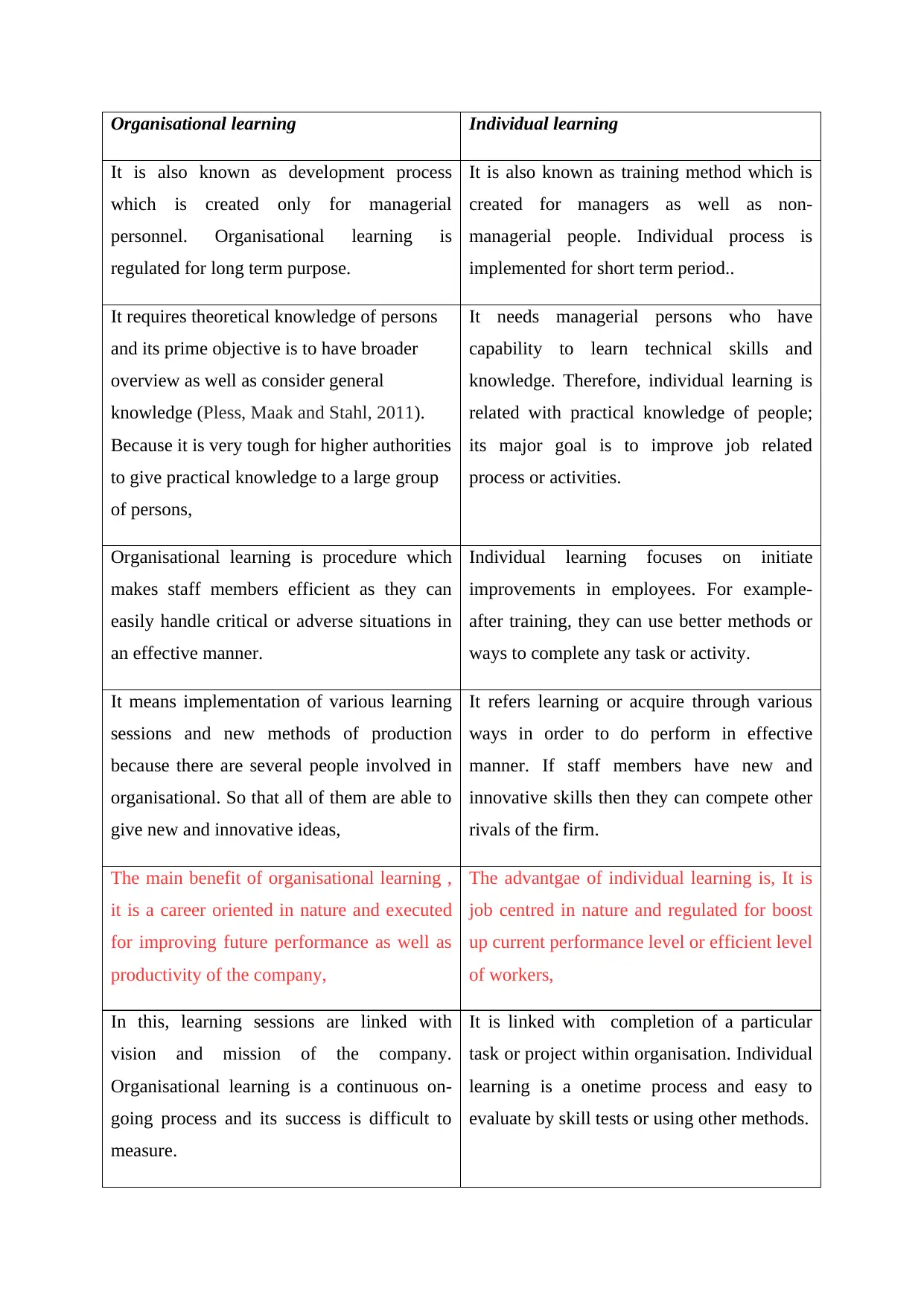
Organisational learning Individual learning
It is also known as development process
which is created only for managerial
personnel. Organisational learning is
regulated for long term purpose.
It is also known as training method which is
created for managers as well as non-
managerial people. Individual process is
implemented for short term period..
It requires theoretical knowledge of persons
and its prime objective is to have broader
overview as well as consider general
knowledge (Pless, Maak and Stahl, 2011).
Because it is very tough for higher authorities
to give practical knowledge to a large group
of persons,
It needs managerial persons who have
capability to learn technical skills and
knowledge. Therefore, individual learning is
related with practical knowledge of people;
its major goal is to improve job related
process or activities.
Organisational learning is procedure which
makes staff members efficient as they can
easily handle critical or adverse situations in
an effective manner.
Individual learning focuses on initiate
improvements in employees. For example-
after training, they can use better methods or
ways to complete any task or activity.
It means implementation of various learning
sessions and new methods of production
because there are several people involved in
organisational. So that all of them are able to
give new and innovative ideas,
It refers learning or acquire through various
ways in order to do perform in effective
manner. If staff members have new and
innovative skills then they can compete other
rivals of the firm.
The main benefit of organisational learning ,
it is a career oriented in nature and executed
for improving future performance as well as
productivity of the company,
The advantgae of individual learning is, It is
job centred in nature and regulated for boost
up current performance level or efficient level
of workers,
In this, learning sessions are linked with
vision and mission of the company.
Organisational learning is a continuous on-
going process and its success is difficult to
measure.
It is linked with completion of a particular
task or project within organisation. Individual
learning is a onetime process and easy to
evaluate by skill tests or using other methods.
It is also known as development process
which is created only for managerial
personnel. Organisational learning is
regulated for long term purpose.
It is also known as training method which is
created for managers as well as non-
managerial people. Individual process is
implemented for short term period..
It requires theoretical knowledge of persons
and its prime objective is to have broader
overview as well as consider general
knowledge (Pless, Maak and Stahl, 2011).
Because it is very tough for higher authorities
to give practical knowledge to a large group
of persons,
It needs managerial persons who have
capability to learn technical skills and
knowledge. Therefore, individual learning is
related with practical knowledge of people;
its major goal is to improve job related
process or activities.
Organisational learning is procedure which
makes staff members efficient as they can
easily handle critical or adverse situations in
an effective manner.
Individual learning focuses on initiate
improvements in employees. For example-
after training, they can use better methods or
ways to complete any task or activity.
It means implementation of various learning
sessions and new methods of production
because there are several people involved in
organisational. So that all of them are able to
give new and innovative ideas,
It refers learning or acquire through various
ways in order to do perform in effective
manner. If staff members have new and
innovative skills then they can compete other
rivals of the firm.
The main benefit of organisational learning ,
it is a career oriented in nature and executed
for improving future performance as well as
productivity of the company,
The advantgae of individual learning is, It is
job centred in nature and regulated for boost
up current performance level or efficient level
of workers,
In this, learning sessions are linked with
vision and mission of the company.
Organisational learning is a continuous on-
going process and its success is difficult to
measure.
It is linked with completion of a particular
task or project within organisation. Individual
learning is a onetime process and easy to
evaluate by skill tests or using other methods.
⊘ This is a preview!⊘
Do you want full access?
Subscribe today to unlock all pages.

Trusted by 1+ million students worldwide
1 out of 18
Related Documents
Your All-in-One AI-Powered Toolkit for Academic Success.
+13062052269
info@desklib.com
Available 24*7 on WhatsApp / Email
![[object Object]](/_next/static/media/star-bottom.7253800d.svg)
Unlock your academic potential
Copyright © 2020–2025 A2Z Services. All Rights Reserved. Developed and managed by ZUCOL.



